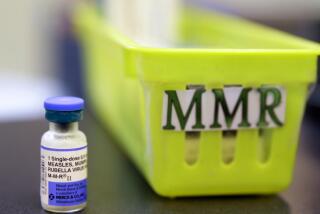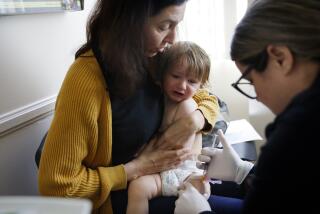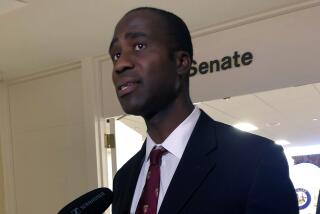Measles Strikes the Young and at Random : Epidemic: Infant’s death from the disease has left his mother warning others about the importance of vaccinations.
Bobbie Owens lived the nightmare of California’s worst measles epidemic in two decades.
Last summer, the Pomona mother was about to have her 11-month-old son vaccinated--about the earliest recommended age for measles vaccination--when he caught the highly contagious virus.
“That still runs through my head, over and over: If he could have just hung on for a few days for that shot,” Owens, a 37-year-old single mother, said last week.
For seven days she tried in vain to break his fever, bathing him in a small tub of cold water. Almost as soon as the measles began dotting his stomach, they turned black from the heat of his tiny body.
Once hospitalized at Childrens Hospital of Orange County, Nathan Timothy--named after Owens’ brother who died of Sudden Infant Death Syndrome--was heavily sedated, and clung to life for a month.
“He never opened his eyes again after we got him there,” said Owens, whose baby died at the hospital on July 10, 1989. “It got to a point where all I hoped for was for him to open his eyes just one more time, so we could look at each other one more time.”
“This is not easy for me to talk about even now,” she added. “I’d just like to say how important these vaccinations are. I wouldn’t want any mother to go through what I’ve been through. Nobody ever thinks they will lose their baby to the measles. My two oldest kids had them and (the measles) were gone in a few days.”
The Owens family’s story underscores how devastating and arbitrary the measles epidemic has been for the handful of Southern Californians who have lost loved ones to a virus that for years seemed a little threat.
Californians have been suffering from measles since 1987, in what state health officials say is the longest running outbreak in the country. Nationwide, public health officials say the epidemic is the worst since an immunization shot was developed in 1963.
Measles outbreaks have been reported in at least 23 states this year, and the number of reported cases is running 70% ahead of last year’s record pace, health officials said.
Before 1963, most American children caught the measles.
The vast majority of measles victims recover without specific treatment beyond fever-reducing medicines and liquids. But in some cases, complications develop, including vomiting, dehydration, pneumonia and encephalitis, and sometimes patients die.
For reasons that are unexplained, there have been a higher percentage of serious complications and deaths in the current California epidemic than in previous epidemics in the state. California’s measles outbreak has been compared by one national health official to that of a Third World nation.
In Los Angeles County, health department officials say that measles have struck 1,500 people this year, killing six. The dead are a 43-year-old, a 29-year-old, a 16-year-old, a 10-year-old cancer patient, and two children less than 3 years old. Statewide, the measles have afflicted 1,800 people, killing 24.
Poor, inner-city children of preschool age--primarily Latinos--have been hit hardest by the epidemic. Lack of government funding has crippled efforts by public health officials to curb the outbreak, also known as red measles or rubeola.
Surveys indicate that as many as 30% of California’s children--and 50% of minority children--have not been vaccinated by age 2. Pediatricians generally advise inoculating babies at 12 to 15 months and again when they reach kindergarten age.
So Bobbie Owens was ahead of schedule when she made a mid-June appointment last year for Nathan’s measles shot. Separated from her children’s father, she was living on state aid and having her medical bills paid by Medi-Cal.
“He had just started learning to walk, saying a few words, like ‘Mama,’ and ‘Dada’ and ‘Digga Digga.’ All those baby goo-goo noises,” Owens said during an interview at her Pomona apartment. She did not know that measles vaccinations do not always take in children less than a year old.
In a way, Owens had already lost one son--to Los Angeles gangs. When her eldest son, Terrell, was 13 and began saluting his junior high pals with gang signs, Owens feared that the peer pressure to join would be too great for a teen-age boy with no big brother or father at home. So she sent him to live with his grandparents in Louisiana. He would never see his only brother.
These and other thoughts filled her head as she sat beside Nathan’s hospital crib each day, 15 or 20 hours sometimes, talking and cooing to her baby.
“They kept telling me there was nothing I could’ve done. But still, you wonder,” Owens said.
Her 10-year-old daughter, Lacreshia, a second mother to Nathan, has been devastated, too. She sometimes wanders out of the room when Nathan’s name comes up. She will only occasionally mention missing her brother.
Owens and her family have handled the ordeal by going to church frequently. There are plenty of pictures of Nathan around their apartment, among the other family photographs and an illustration of the Last Supper.
“I couldn’t have got through this without praying,” Owens said. “I have to think that for some reason this was meant to be.”
More to Read
Sign up for Essential California
The most important California stories and recommendations in your inbox every morning.
You may occasionally receive promotional content from the Los Angeles Times.










